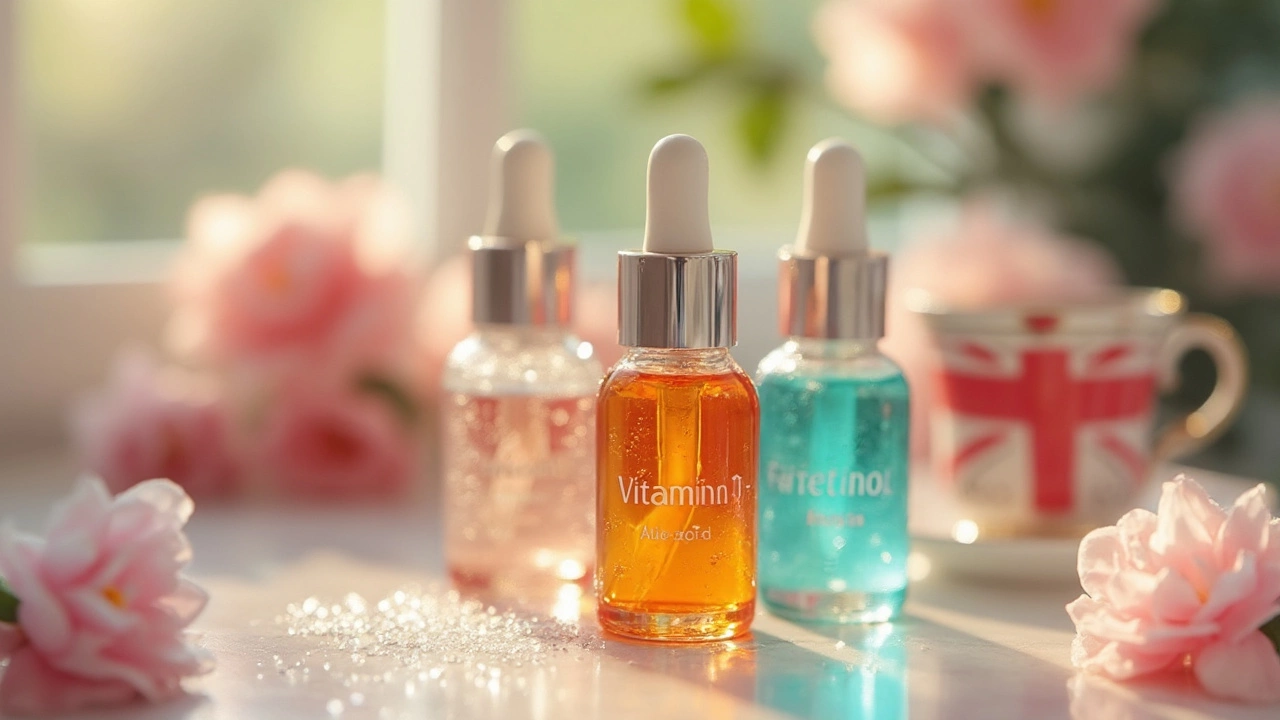Everyone has their favorite product that they swear makes them glow—mine used to be a very basic moisturizer until I started falling down the endless rabbit hole of Vitamin C, hyaluronic acid, and retinol. Skincare trends shift almost as fast as TikTok dances, but these three ingredients have real sticking power in the beauty world. Yet the question that gets asked more than anything: Can you actually use these three together, or is that a recipe for redness and regret?
Breaking Down the Super Trio: What Does Each Ingredient Do?
Let’s start with why these three are always at the top of must-have lists. Vitamin C (ascorbic acid on the back of your bottle) isn’t just a thing for your immune system—it’s a superstar when it comes to fi ghting dullness. This potent antioxidant helps fade dark spots, smoothes skin tone, and acts kind of like a tiny shield against pollution and UV damage you don’t even realize you’re collecting on your commute. Research in dermatology journals since the early 2010s points to its ability to boost collagen, making your skin firmer over time. It’s no magic wand, but it delivers.
Then there’s hyaluronic acid. This one sounds kind of intimidating in name—like something that would make your skin peel—but it’s actually the exact opposite. This molecule naturally exists in your skin and can hold up to 1,000 times its own weight in water. What does that mean for your face? Bounce. Juiciness. A sort of plush glow that makes you look awake even if you didn’t sleep well because your cat, like my Tinsel, decided 2 a.m. was play time. And because hyaluronic acid isn’t an exfoliator or active, it plays nice with almost anything you put on top or underneath it.
Retinol is the ingredient that everyone is low-key afraid of but really shouldn’t be, especially with the right approach. It’s a Vitamin A derivative and is honestly the gold standard in the anti-aging arena. Dermatologists recommend retinoids for acne, wrinkles, sun spots, and even texture issues. But with all its power comes some risk: overdo it, and you risk redness, sensitivity, and flaking. But when used correctly? It makes your skin look smoother and softer over time—researchers agree it accelerates skin turnover which reduces fine lines and clears breakouts.
Here’s a quick snapshot of what they each bring to the table if you like numbers:
| Ingredient | Main Benefit | Key Research |
|---|---|---|
| Vitamin C | Evens tone, boosts collagen | 2013 Journal of Clinical Interventions in Aging |
| Hyaluronic Acid | Deep hydration | 2011 International Journal of Biological Macromolecules |
| Retinol | Anti-aging, acne-fighter | 2018 American Academy of Dermatology |
Is It Safe to Mix Vitamin C, Hyaluronic Acid, and Retinol?
This is the bit where a lot of people get nervous, fearing if you combine these heavy hitters you’ll end up looking like a tomato. Good news—combining vitamin C, hyaluronic acid, and retinol is actually safe for most people, if you do it the smart way. Not everything in skincare is like mixing vinegar and baking soda. The most common stumbling block comes from the fact that Vitamin C is usually acidic, and retinol is most effective at a neutral/ slightly basic pH. Some folks worry they’ll cancel each other out, but research shows that layering them with a little patience works. In fact, layering hydrators like hyaluronic acid between the other two creates more balance and less irritation.
Here’s how the experts typically recommend using them:
- Apply Vitamin C serum first thing in the morning after you cleanse (before moisturizer and sunscreen), since it fights off environmental stressors.
- Layer hyaluronic acid after Vitamin C, because humectants help pull moisture deeper into your newly protected skin barrier. Bonus: It cushions sensitive skin from stronger actives.
- Retinol comes at night, always. It makes your skin more sun sensitive, and your skin does its best repair work while you sleep. (That’s also why you apply retinol after cleansing at bedtime and then follow with moisturizer or more hyaluronic acid for comfort.)
So, as long as you don’t throw all three on at the same time, mixing is totally possible. Yes, there’s a catch: sensitive skin types should always introduce actives one at a time for at least two weeks, so you can pinpoint which ingredient sets off a reaction. My friend Clara tried to launch into the full routine in three days and called me in tears—her cheeks were on fire. Starting slow wins the race here.

Building the Right Routine: Application Order and Tips
If you’ve ever stared at a shelf of serums wondering what goes on first, you’re not alone. The trick is to think about the texture and the purpose of each ingredient. Thinner, water-like serums go on first, then anything thicker, finally locking it in with creamier moisturizers. And always, always wait a minute or two between layers to give your skin time to soak it in.
- Morning: Cleanse – Vitamin C – Hyaluronic Acid – Moisturizer – Sunscreen
- Night: Cleanse – Retinol – Hyaluronic Acid – Moisturizer
Another tip: Don’t forget about the neck and chest. These areas show signs of aging early and get forgotten. Also, make sure everything is totally dry between steps, especially before you apply retinol—damp skin absorbs actives faster, which can sometimes lead to irritation. (Been there, regretted it.)
If you’re worried about reactions, patch test each new product on your jawline or behind your ear, especially if you’ve had issues before. Dermatologists say that certain combinations work better based on your skin’s needs and tolerance. For example, if you’re using a prescription retinoid, you might want to skip Vitamin C completely in the same routine or use it every other day instead. Listen to your skin—it tells you what it wants.
My own routine looks something like this: In summer, I’ll use Vitamin C every morning for protection and brightness, layering hyaluronic acid over it for dewiness. At night, it’s retinol two to three nights a week, hyaluronic acid again, and then a fragrance-free moisturizer. If my skin feels tight, I take a night off and just use hyaluronic acid and moisturizer—your skin barrier needs breaks too, not just trendy ingredients.
What Kind of Results Should You Expect?
This is where things get both exciting and a little frustrating. Because your skin turns over about every 28 days, visible results take patience. Vitamin C can brighten and fade pigmentation after four to six weeks of daily use, based on research from university dermatology clinics. Hyaluronic acid gives an instant plumping effect (don’t expect miracles—it won’t erase wrinkles but it does smooth the look of fine lines). Retinol takes the longest—sometimes up to 12 weeks for something you’ll really notice, which is why so many people give up before it works. Don’t be that person; consistency pays off.
Curious if the results are truly noticeable? Skincare studies have tested this combo on volunteers in clinical settings. A 2017 study found that folks who layered Vitamin C and hyaluronic acid had fewer dark spots in as little as a month than those who used moisturizer alone. Retinol’s effects were more subtle at first but started showing up in firmness and smoothness at the six-week mark.
- Improved skin texture (more even, less rough patches)
- Reduction in appearance of fine lines and crow’s feet
- Brighter complexion and less visible sun spots
- Increased moisture retention (think less parched or flaky skin)
Remember, everyone’s skin is like its own unique snowflake. What works for your friend might need tweaking for you. You can always customize—some people swap Vitamin C for niacinamide, or use a gentler retinol called retinaldehyde if their skin gets easily upset.

Common Mistakes and How to Avoid Them
Even the savviest skincare junkie makes a wrong turn sometimes. The four most common fails:
- Skipping sunscreen. The sun doesn’t care about your fancy new routine; Vitamin C and retinol can make skin super sensitive to rays, so if you’re skipping SPF, you’re basically undoing your own hard work.
- Using too much product. More isn’t always better. Think pea-sized for serums. Overusing actives leads to redness and flaky skin—just ask anyone who accidentally combined multiple actives in one night.
- Ignoring your skin’s cues. If you’re flaking, burning, or breaking out, take a break and go back to basics. Sometimes the products just aren’t for you. Your skin knows best.
- Not layering properly. Putting retinol on damp skin or mixing it directly with Vitamin C in your palm can be too much. Space them out in your routine or use on alternating days if you’re struggling with irritation.
If you really want to geek out and dig into the science, look up ingredient pH compatibility charts—some brands proudly announce their formulas are stable together, but you don’t want to experiment unless you love the thrill of potential redness (I do not!). And I’ll say it again because it’s that key: sunscreen, every single morning, rain or shine. A broad spectrum SPF 30+ is non-negotiable if you want to keep your glow and protect your barrier.
Lastly, keep in mind life changes things. Hormones, diet, stress—they all show up on your face. If your routine isn’t cutting it, tweak the frequency and brands. As for your wallet, you can definitely find affordable options that work: some of my favorites are drugstore serums with proven formulas, and I nearly always use a simple, no-nonsense hyaluronic acid serum as the backbone of my routine. There’s no shame in keeping it budget-friendly if results show!
So yes, you can absolutely use vitamin C, hyaluronic acid, and retinol together as long as you know how to layer—and listen to what your skin and life schedule are telling you. Your best skin is often just a few tweaks away, not a total overhaul. Also, don’t forget to pet your cat. It’s proven to lower stress, which may help your glow stay put too.
